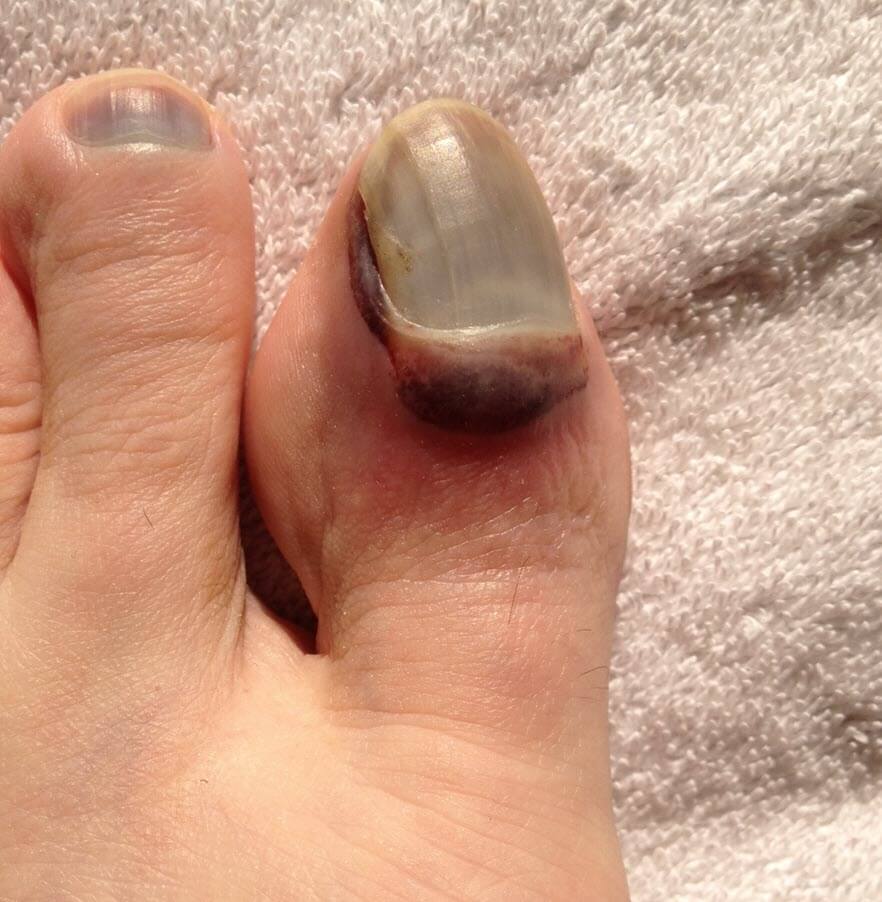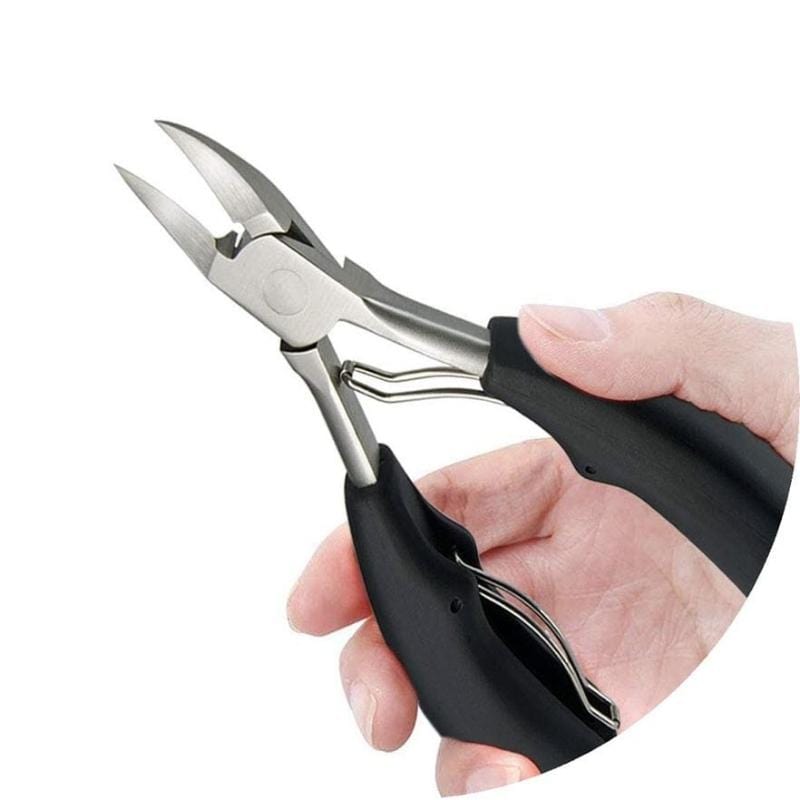Toenail blisters and black toenails can be terribly painful and difficult to treat. Thankfully, they are easy to avoid, once you determine their cause. That's what I'll be helping you with in this article.
The Mechanics of Toenail Blisters
The first thing to know about toenail blisters is this: toenails are attached to the skin underneath them. That skin is called the nail bed. When something pushes on the end of the toenail, it moves the nail and nail bed skin backwards towards you.
All good so far?
Now think about the bone of the toe directly under the nail. It's not moving backward. In fact, it's often moving forwards.
The result is soft tissue shear (think of it as stretching). With the nail/skin moving one way and the bone moving the other way, all the soft tissue between skin and bone stretches.
If this happens often enough, a blister will form under the toenail. The blister will either lift the whole nail up; or it will form around the edge of the nail. Below are two photos that show this.
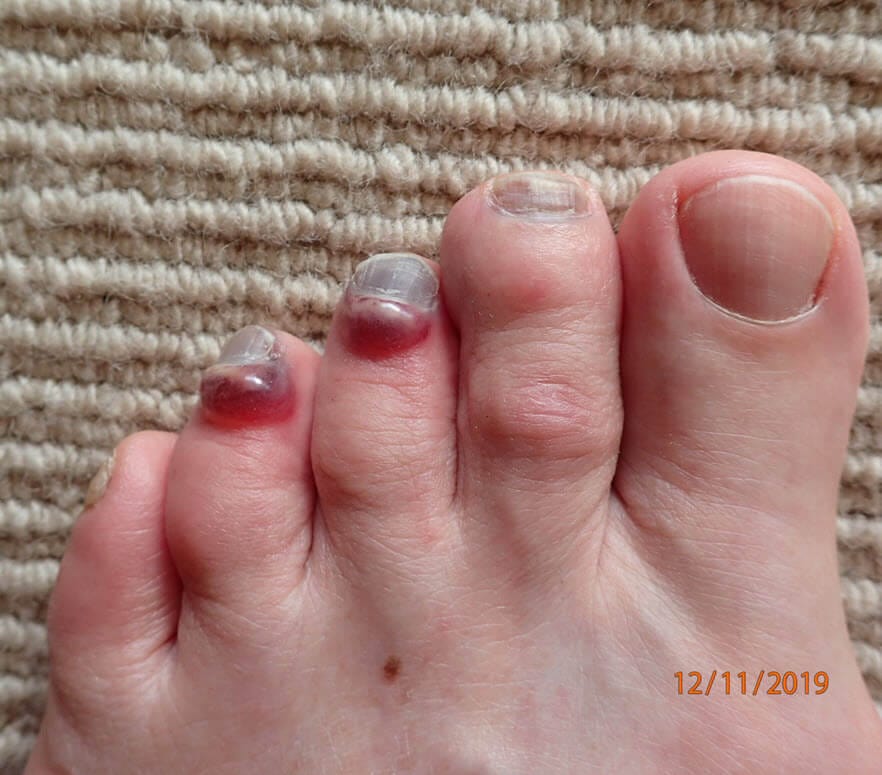
Toenail blood blisters
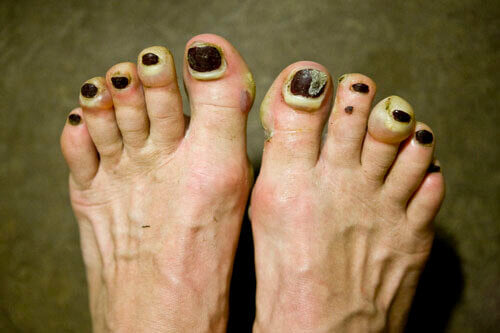
The best (worst) photo of toenail blisters I've seen, courtesy of John Vonhof at Fixing Your Feet (the black is nail varnish, but still!).
What Causes Toenail Blisters and Black Toenails?
If your nail is pushed repeatedly, let's say because your nails are too long or your foot is moving too far forward in the shoe, you can get a blister either:
- A blister under and/or around the toenail - often due to long toenails, stubbing your toe or the foot moving too far forward in the shoe.
- A blister on the tip of your toe - often due to clawed toes (toes bent over with weightbearing pressure to the tip of the toe).
- A black toenail - often due to a single episode of vertical pressure to the toenail, like someone jumping on your toe or dropping something on your toe.
Treating Painful Toenail Blisters
When you get a blister, the upper layers of skin "bubble up" in order to hold the fluid being formed by the body. The skin expands as much as it needs too, to hold that fluid. On the other hand, blisters under the nail are much more painful. Think about the anatomy. You have the toe bone below, the rigid nail on top, and the very sensitive nail bed in between. As blood or blister fluid forms, it's stuck between a rock and a hard place with nowhere to go. Pressure builds and significant pain is the result (a deep ache or throbbing) even when you're not on your feet. The only way to relieve this pain is to release the blister fluid. This usually requires drilling a hole in the nail. With the right equipment, it's easy and painless to do. After that, relief will be immediate.
If your toenail blister extends from under the nail to one or more of the four sides of the nail, the job is a lot easier. You can simply lance the blister by piercing the skin adjacent to the nail. With a sterile scalpel blade or hypodermic needle, this is also easy and painless to do. And relief will be immediate.
The 7 Toenail Blister Scenarios and Their Fixes
There is more than one cause of toenail blisters. Understand the cause and you'll be able to prevent them. Let's look at 7 scenarios likely to lead to blisters around the tip of the toe and toenails.
Scenario 1: Shoes Too Small
This is obvious. When your shoes are too small and your toes hit the end, the nail is pushed back into the toe. And don't forget, swelling can make an otherwise well-fitting shoe too small.
The Fix
You can tape or lube your toes 'til the cows come home, but you won’t stop a toenail blister if your shoes are too small. Other than cutting the toe out of your shoe, they're always going to be too small. There is no other way around it, you need new shoes.
If you're in a multiday event, you may need more than one pair of shoes to cope with swelling. It's common practice for ultrarunners to use 2 or more pairs of shoes of increasing size over the course of the race for this reason.
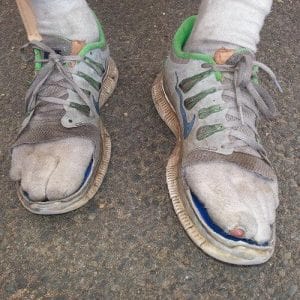
The hole at the big toe of the left sock suggests this provided relief to the tips of the toes.
Scenario 2: Shoes Too Big
A shoe that's too big and loose will allow your foot to slide forward. The giveaway is there’ll be a gap behind your heel and your toes will hit the end of the shoe. This is almost as bad as having shoes that are too small. But there is one thing you can try before you throw them out.
The Fix
Special lacing techniques help to keep your heel at the back of the shoe; stopping your foot sliding forward and toes hitting the end of the shoe. My personal favourite is the lace-lock technique.
Scenario 3: Nail Shapes and Deformities
Some people have nails that are very thick. The higher they protrude upwards, the more likely they’ll be pushed by the top of the shoe. Others have normal nail thickness but the nail bed is elevated, causing the nail to be domed (pictured below). And others have a toenail that is angled upwards (it’s not parallel with the toe). For different reasons the same thing happens - the nail is more likely to get pushed on from the shoe.
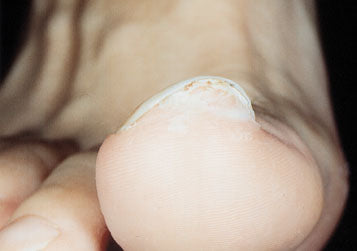
Elevated or thickened nails predispose to toenail blisters
The Fix
If the nail is thick, do your best to file it down. A podiatrist can help if you can't seem to get anywhere with it. W have a machine called a drill (which is basically a grinder) that painlessly thins even the thickest nails.
If your nail is not thick but it sits high (pictured below), or it's angles upwards, it's a little more difficult to deal with and may take a surgical procedure to fix properly. If you're not keen on this and you want to find a conservative solution, you need to find shoes that are as deep as possible in the toebox to be able to accommodate the nail deformity. In other words, give the nail the room it needs.
Scenario 4: “Cocked-Up” Big Toe
Some people have a hyperextended interphalangeal joint of the big toe. See the exaggerated crease in the middle of the toe (arrow). This "cocked-up" big toe results in the end of the toe, and therefore the nail, pointing upwards rather than being parallel with the floor. The toenail gets pressure from the top of the shoe and is pushed back into the toe with each step - if the shoe is not deep enough in the toebox.
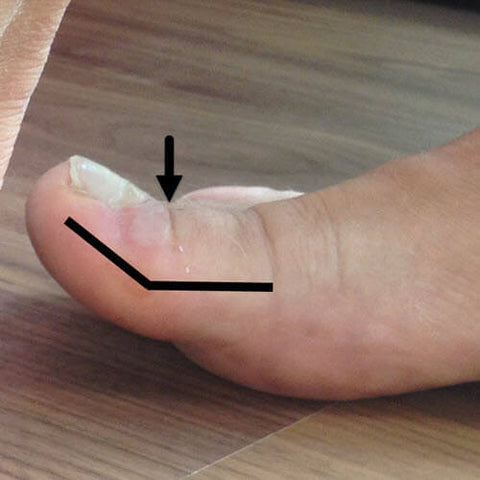
Big toe cocked-up (Hyperextended interphalangeal joint)
The Fix
This cocked-up position is a common consequence of the big toe knuckle (1st MPJ) being stiff. This stiffness may be functional or structural and each has a different fix.
- A functional stiffness can be helped by a podiatrist. Depending on your mechanics, this may involve orthotics (with specific additions for the "functional hallux limitus" issue), heel lifts, calf stretches or a few other modalities, all aimed at improving windlass mechanism function. Have a look at the moving image. To start with, the toe is cocked-up at the end making the toenail angle upwards. But a simple piece of material under the the first bone of the toe makes it sit more level with the floor. This is just one example of what a podiatrist can do to change your foot mechanics to help you prevent toenail blisters of the big toe.
- A structural (bony) stiffness is not so easy. Talk to your podiatrist about the options (different types of orthotics, footwear modifications, surgery if it's a big enough problem for you). Or do what you can to get shoes that are really deep in the toe-box to accommodate it. This can be easier said than done with running shoes. Ladies, consider buying men's runners - they are a bit deeper for the length.
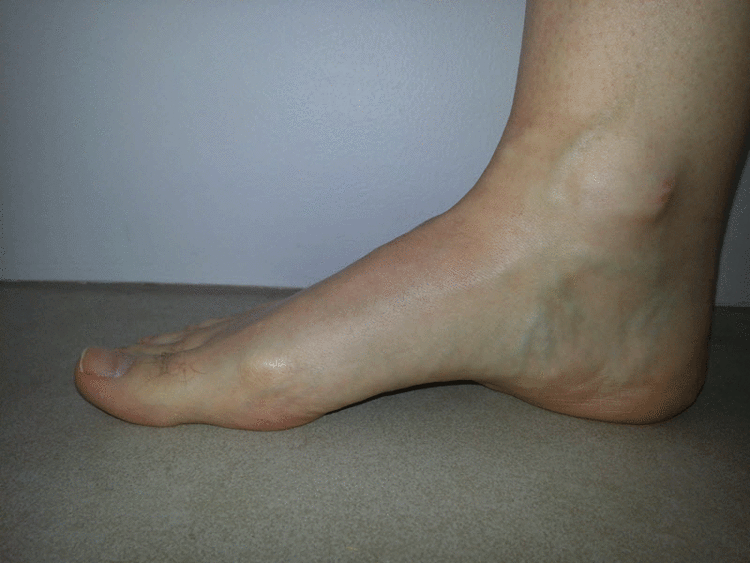
To start with, the toenail is angled upwards. The material under the the first bone of the toe makes the nail sit more level with the floor to help prevent toenail blisters of the big toe.
Scenario 5: Clawed or Hammer Toes
Do you get blisters on your smaller toes (usually toes 2-5) because your toes bend downwards? This is called clawed toes. The tips of the toes sustain weightbearing pressure and that means the nail is pushed back into the toe with every step. There are degrees of clawed toes. And there are different reasons for clawing.
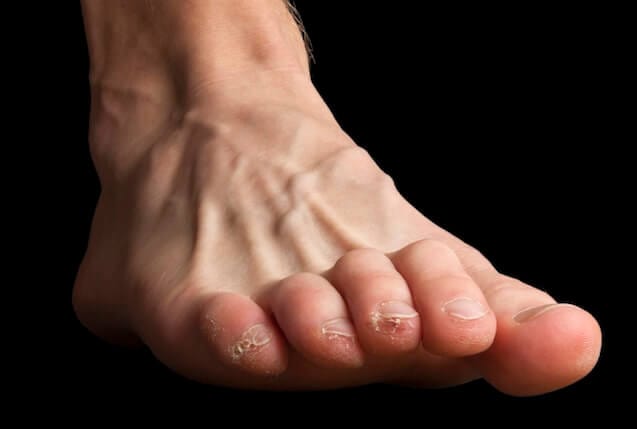
Clawed toes cause weightbearing pressure to be exerted on the end of the toenails
The Fix
Some people have perfectly straight toes but they claw only when walking and running. At the other end of the spectrum, toes can be in a fixed clawed position so you are walking right on the tip of the toe.
Either way, the aim is to stop you from walking on the tips of the toes, or at least to lessen the weightbearing pressure. This is what toe-props do. Toe-props take up the space under your toes and encourage your toes to sit straighter. Even if your toes are fixed, a toeprop will allow a spreading of the load to the under-surface of the toes, so there's not quite so much force pushing the nail back.
Types of Toe-Props
There are several forms of toe-props. You can find pre-made toe props at the chemist (like this yellow one). And custom made toe props are made by a podiatrist (the pink one - watch the 48 sec video). Podiatrists can also help to identify if there are fixable reasons why your toes are clawing.
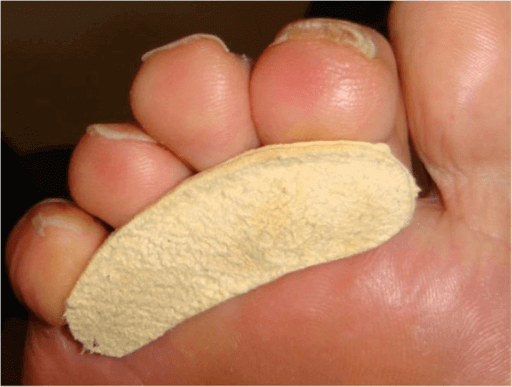
Pre-made toe prop. Elastic holds it onto the toe.
Toe props can be great for everyday use and they last a long time (usually a year or more - for the custom made ones). Most runners with toenail blister problems are wary of putting something foreign between their toes. The concern is the device itself will cause more problems than it fixes. So experiment to ensure the prop you've chosen is suitable for long durations.
If toe-props don't work, consider the gel toe sleeves that are closed in at the end (available at most chemists and from our online store - pads & cushions). They will provide cushioning and apical shear absorption which is better than nothing, but not my first choice.
Scenario 6: Downhill Terrain
Running or walking downhill causes your foot to move forward in the shoe with more force and you're more likely to get toenail blisters than if you were on the flat or going uphill.
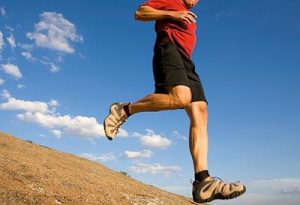
The Fix
The lacing technique shown earlier will help keep your foot back in the shoe. And modifying your gait so that your foot doesn't land too far in front of you will also help.
Scenario 7: Long, Thick or Rough Toenails
When your nails are long, thick or rough, you just make all of the above situations worse.
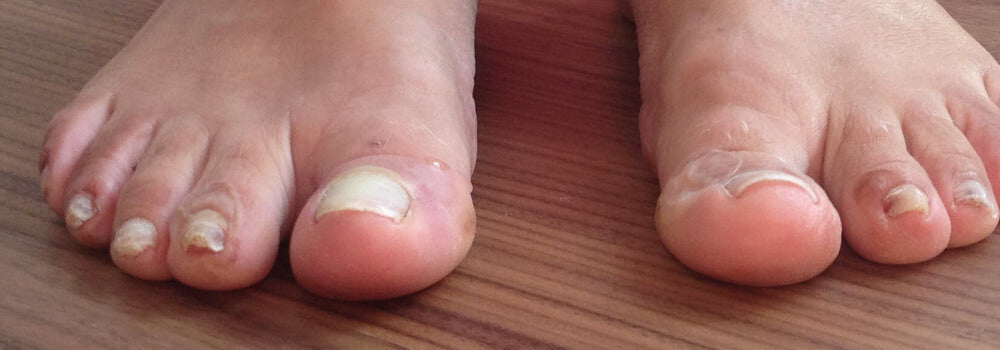
The middle 3 toenails of the right foot are too long, thick and rough. Keep them as thin and short and smooth as possible to avoid toenail blisters.
The Fix
Keep your nails short and thin and smooth. Neglect this and you're asking for toenail blisters. See a podiatrist if you need to - as I mentioned earlier, we have specialised equipment to help get your gnarly nails into much better shape and keep them out of trouble - and it doesn't even hurt! Or get a great pair of toenail clippers for thick nails that are extremely sharp, like ours.
Toenail Blister Case Study
Treating Blisters Under The Toenail
To release the blister fluid from under the nail, you're going to need a few things. If you need to drill a hole through the nail, you'll need a hypodermic needle. If you're lucky and the blister has extended past the margins of the nail, you can lance that skin with a scalpel blade. Soak up as much blister fluid as you reasonably can, apply an antseptic or antibiotic, then cover it with an island dressing to keep it clean and to soak up the blister fluid that will continue to drain. The Blister Kit - Sterile Blister Lance Pack below is everything you'll need to perform 4 blister draining and treatment episodes, without your blister getting infected. You can get one of these from our online store.
Conclusion
Some causes of toenail blisters are easy to fix yourself - a bit of common sense and preparedness goes a long way. Others you might need some help with. If you're getting blisters around your toenails in spite of your best efforts, see a podiatrist.
And...
Make sure you've got some excellent toenail clippers to keep your toenails under control. Grab your own set below.
